CLAT PG - Cell - the unit of life 1000+ MCQ [Solved] PDF Download
Thursday 9th of March 2023

Sharing is caring
1. What would happen if lysosomes get ruptured in a cell?
A. Cell dies
B. Cell shrinks
C. Cell swell up
D. Nothing would happen
Answer : A
A. Cell dies
B. Cell shrinks
C. Cell swell up
D. Nothing would happen
Answer : A
2. An organalle devoid of membrane covering is
A. vacuole
B. ribosome
C. peroxisome
D. lysosome
Answer : B
A. vacuole
B. ribosome
C. peroxisome
D. lysosome
Answer : B
3. Which of the following is not the function of cell wall?
A. Only (i)
B. Only (iv)
C. Only (ii), (iii) and (iv)
D. None of the above
Answer : D
- Provides shape to the cell.
- Protects the cell from mechanical damage and infection.
- Helps in cell to cell interaction.
- Provides barrier to undesirable macromolecules.
A. Only (i)
B. Only (iv)
C. Only (ii), (iii) and (iv)
D. None of the above
Answer : D
4. Match the items given in column-I with their role given in column-II and choose the correct option.
A. A V; B III; C I; D IV; E II
B. A V; B III: C II; D IV; E I
C. A II; B III; C I; D IV; E V
D. A III; B IV; C I; D V; E II
Answer : A
| Column-I | Column-II |
|---|---|
| A. SER | I. Increase the surface area |
| B. Golgi apparatus | II. Store oils or fats |
| C. Cristae | III. Excretion |
| D. Peroxisome | IV. Photorespiration |
| E. Elaioplasts | V. Synthesis of lipid |
A. A V; B III; C I; D IV; E II
B. A V; B III: C II; D IV; E I
C. A II; B III; C I; D IV; E V
D. A III; B IV; C I; D V; E II
Answer : A
5. Prokaryotic and eukaryotic flagella differ in the
A. type of movement and placement.
B. location and mode of functioning.
C. microtubular structure and function.
D. microtubular organization and type of movement.
Answer : D
A. type of movement and placement.
B. location and mode of functioning.
C. microtubular structure and function.
D. microtubular organization and type of movement.
Answer : D
6. Active transport differs from passive transport in that active transport
A. requires energy.
B. always requires input of ATP.
C. moves molecules against a concentration gradient.
D. both (a) and (c)
Answer : D
A. requires energy.
B. always requires input of ATP.
C. moves molecules against a concentration gradient.
D. both (a) and (c)
Answer : D
7. The figure below shows the structure of a mitochondrion with its four parts labelled (A), (B), (C) and (D).

Select the part correctly matched with its function.
A. Part (D): Outer membrane Gives rise to inner membrane by splitting.
B. Part (B): Inner membrane Forms infoldings called cristae.
C. Part (C): Cristae Possess single circular DNA molecule and ribosomes.
D. Part (A): Matrix Major site for respiratory chain enzymes.
Answer : B

Select the part correctly matched with its function.
A. Part (D): Outer membrane Gives rise to inner membrane by splitting.
B. Part (B): Inner membrane Forms infoldings called cristae.
C. Part (C): Cristae Possess single circular DNA molecule and ribosomes.
D. Part (A): Matrix Major site for respiratory chain enzymes.
Answer : B
8. The cytoskeleton is a proteinaceous network of fibres in the cytoplasm. It is involved in
A. mechanical support.
B. motility.
C. maintenace of cell-shape.
D. all of the above
Answer : D
A. mechanical support.
B. motility.
C. maintenace of cell-shape.
D. all of the above
Answer : D
9. Which of these is wrongly matched?
A. Chloroplasts Chlorophyll
B. Elaioplasts Starch
C. Chromoplasts Carotenoids
D. Amyloplasts Carbohydrates
Answer : B
A. Chloroplasts Chlorophyll
B. Elaioplasts Starch
C. Chromoplasts Carotenoids
D. Amyloplasts Carbohydrates
Answer : B
10. pH of vacuolar cell sap is
A. neutral and isotonic.
B. alkaline and isotonic.
C. acidic and hypertonic.
D. equal to cytoplasm and isotonic.
Answer : C
A. neutral and isotonic.
B. alkaline and isotonic.
C. acidic and hypertonic.
D. equal to cytoplasm and isotonic.
Answer : C
11. Which of the following statements is/are correct ?
A. (i), (ii), (iii) and (iv)
B. Only (i) and (ii)
C. Only (iv)
D. None of the above
Answer : A
- The shape of the cells may vary with the function they perform.
- Human RBC is about 7.0 ??m in diameter.
- Cytoplasm is the main area of cellular activities.
- Various chemical reactions occur in cytoplasm to keep the cell in the living state.
A. (i), (ii), (iii) and (iv)
B. Only (i) and (ii)
C. Only (iv)
D. None of the above
Answer : A
12. The following diagram represents a structure chromosome.
Identify the structures marked as A, B and C.
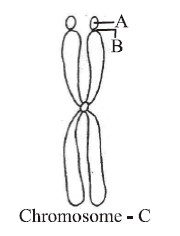
A. A - Satellite, B - Primary constriction, C - Acrocentric
B. A - Satellite, B - Secondary constriction, C - Metacentric
C. A - Satellite, B - Centromere, C - Telocentric
D. A - Satellite, B - Centromere, C - Submetacentric
Answer : B
Identify the structures marked as A, B and C.

A. A - Satellite, B - Primary constriction, C - Acrocentric
B. A - Satellite, B - Secondary constriction, C - Metacentric
C. A - Satellite, B - Centromere, C - Telocentric
D. A - Satellite, B - Centromere, C - Submetacentric
Answer : B
13. Which of the following statement is correct regarding vacuole?
A. It is membrane-bound and contains storage proteins and lipids.
B. It is membrane-bound and contains water and excretory substances.
C. It lacks membrane and contains air.
D. It lacks membrane and contains water and excretory substances.
Answer : B
A. It is membrane-bound and contains storage proteins and lipids.
B. It is membrane-bound and contains water and excretory substances.
C. It lacks membrane and contains air.
D. It lacks membrane and contains water and excretory substances.
Answer : B
14. Nucleolus is
A. rounded structure found in cytoplasm near nucleus.
B. rounded structure inside nucleus and having rRNA.
C. rod-shaped structure in cytoplasm near the nucleus.
D. none of the above.
Answer : B
A. rounded structure found in cytoplasm near nucleus.
B. rounded structure inside nucleus and having rRNA.
C. rod-shaped structure in cytoplasm near the nucleus.
D. none of the above.
Answer : B
15. According to widely accepted fluid mosaic model cell membranes are semi-fluid, where lipids and integral proteins can diffuse randomly. In recent years, this model has been modified in several respects. In this regard, which of the following statements is incorrect?
A. Proteins in cell membranes can travel within the lipid bilayer.
B. Proteins can also undergo flip-flop movements in the lipid bilayer.
C. Proteins can remain confined within certain domains of the membrane.
D. Many proteins remain completely embedded within the lipid bilayer.
Answer : B
A. Proteins in cell membranes can travel within the lipid bilayer.
B. Proteins can also undergo flip-flop movements in the lipid bilayer.
C. Proteins can remain confined within certain domains of the membrane.
D. Many proteins remain completely embedded within the lipid bilayer.
Answer : B
16. You are asked to examine a cell using a powerful light microscope. The image you see has a clearly defined nucleus and mitochondria. It also has a large central vacuole and chloroplasts. From what group of organisms did this cell most likely come?
A. Bacteria
B. Protists
C. Fungi
D. Plants
Answer : D
A. Bacteria
B. Protists
C. Fungi
D. Plants
Answer : D
17. The lipid component of the membrane mainly consists of __________.
A. polysaccharides
B. phosphoglyceride
C. monosaccharaides
D. both (a) and (c)
Answer : B
A. polysaccharides
B. phosphoglyceride
C. monosaccharaides
D. both (a) and (c)
Answer : B
18. Which of the following option correctly match A, B, C, and D indicated in the given sectional view of chloroplasts.

A. A - Thylakoid, B-Stromal lamella, C - Stroma, D - Granum
B. A - Granum, B - Thylakoid, C - Stromal lamella, D - Stroma
C. A - Thylakoid, B - Granum, C - Stromal lamella, D - Stroma
D. A - Granum, B - Thylakoid, C - Stroma, D - Stromal lamella
Answer : B

A. A - Thylakoid, B-Stromal lamella, C - Stroma, D - Granum
B. A - Granum, B - Thylakoid, C - Stromal lamella, D - Stroma
C. A - Thylakoid, B - Granum, C - Stromal lamella, D - Stroma
D. A - Granum, B - Thylakoid, C - Stroma, D - Stromal lamella
Answer : B
19. Who proposed the theory that Cells arise only from the pre-existing cells?
A. Mohl
B. Virchow
C. Haeckel
D. Brown
Answer : B
A. Mohl
B. Virchow
C. Haeckel
D. Brown
Answer : B
20. Function of RER is
A. autolysis
B. protein synthesis
C. lipid synthesis
D. carbohydrate synthesis
Answer : B
A. autolysis
B. protein synthesis
C. lipid synthesis
D. carbohydrate synthesis
Answer : B
21. Read the statements given below with regard to the functions performed by Golgi apparatus ?
Which of the following is the correct answer ?
A. (i) is wrong but (ii) and (iii) are correct
B. (ii) is wrong but (i) and (iii) are correct
C. (ii) and (iii) are wrong but (i) is correct
D. All are correct.
Answer : D
- Transport and chemically modify the materials contained within it.
- Performs the function of packaging materials.
- Important site of formation of glycoproteins and glycolipids.
Which of the following is the correct answer ?
A. (i) is wrong but (ii) and (iii) are correct
B. (ii) is wrong but (i) and (iii) are correct
C. (ii) and (iii) are wrong but (i) is correct
D. All are correct.
Answer : D
22. The membrane of the erythrocytes has approximately ___% of proteins and ___% lipids.
A. 42, 50
B. 52, 40
C. 50, 50
D. 60, 40
Answer : B
A. 42, 50
B. 52, 40
C. 50, 50
D. 60, 40
Answer : B
23. The main organelle involved in modification and routing of newly synthesized proteins to their destinations is
A. chloroplast
B. mitochondria
C. lysosome
D. endoplasmic reticulum
Answer : D
A. chloroplast
B. mitochondria
C. lysosome
D. endoplasmic reticulum
Answer : D
24. 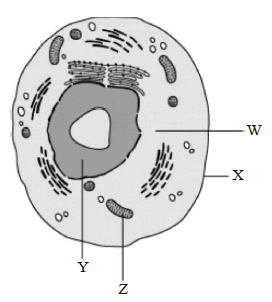
Which cellular structure helps in transferring genetic information from one generation to another?
A. W
B. X
C. Y
D. Z
Answer : C

Which cellular structure helps in transferring genetic information from one generation to another?
A. W
B. X
C. Y
D. Z
Answer : C
25. Which of the following statement of a bacterial cell is/are correct?
A. (i), (ii), (iii)
B. All of the above
C. (ii) & (iv)
D. None of the above
Answer : A
- Mesosome is formed by the extensions of plasma membrane into the cell.
- The pili are elongated tubular structures made up of a protein.
- Flagellum is composed of filament, hook and basal body.
- Ribosomes are about 30 nm by 50 nm in size.
A. (i), (ii), (iii)
B. All of the above
C. (ii) & (iv)
D. None of the above
Answer : A
26. _______________ is the important site of formation of glycoproteins and golycolipids.
A. SER
B. Lysosome
C. Golgi apparatus
D. Mitochondria
Answer : C
A. SER
B. Lysosome
C. Golgi apparatus
D. Mitochondria
Answer : C
27. Which one of the following cellular parts is correctly matched with their characters ?
A. Centrioles Sites for active RNA synthesis.
B. Lysosomes Optimally active at a pH of about 8.5.
C. Thylakoids Flattened membranous sacs forming the grana of chloroplasts.
D. Ribosomes Those on chloroplasts are larger (80S) while those in the cytoplasm are smaller (70S).
Answer : C
A. Centrioles Sites for active RNA synthesis.
B. Lysosomes Optimally active at a pH of about 8.5.
C. Thylakoids Flattened membranous sacs forming the grana of chloroplasts.
D. Ribosomes Those on chloroplasts are larger (80S) while those in the cytoplasm are smaller (70S).
Answer : C
28. Which of the following pair are correctly matched ?
(I) Amyloplasts Store proteins
(II) Mitochondrion Power house of the cell
(III) Stroma Chlorophyll pigment
(IV) Axoneme 9 + 2 array
A. (I) and (III) only
B. (II), (III) and (IV) only
C. (III) and (IV) only
D. (II) and (IV) only
Answer : D
(I) Amyloplasts Store proteins
(II) Mitochondrion Power house of the cell
(III) Stroma Chlorophyll pigment
(IV) Axoneme 9 + 2 array
A. (I) and (III) only
B. (II), (III) and (IV) only
C. (III) and (IV) only
D. (II) and (IV) only
Answer : D
29. Which of the following is absent in prokaryotes?
A. DNA
B. RNA
C. Plasma membrane
D. Mitochondria
Answer : D
A. DNA
B. RNA
C. Plasma membrane
D. Mitochondria
Answer : D
30. Membranous extensions in blue green algae are known as
A. phytochrome
B. chromatophore
C. mesosome
D. pneumatophore
Answer : B
A. phytochrome
B. chromatophore
C. mesosome
D. pneumatophore
Answer : B
31. Microtubules are absent in
A. mitochondria
B. centriole
C. flagella
D. spindle fibres
Answer : A
A. mitochondria
B. centriole
C. flagella
D. spindle fibres
Answer : A
32. Which of the following statements are incorrect ?
A. (i) and (iii)
B. (iii) and (iv)
C. (ii) and (iv)
D. (i) and (iv)
Answer : A
- Plant cells have centrioles which are absent in almost all animal cells.
- Ribosomes are the site of protein synthesis.
- The middle lamella is a layer mainly of calcium carbonate which holds the different neighbouring cells together.
- In animal cell, steroidal hormones are synthesized by smooth endoplasmic reticulum. Of the above statements
A. (i) and (iii)
B. (iii) and (iv)
C. (ii) and (iv)
D. (i) and (iv)
Answer : A
33. Basal bodies are associated with the formation of
A. phragmoplast
B. cilia and flagella
C. cell plate
D. kinetochore
Answer : B
A. phragmoplast
B. cilia and flagella
C. cell plate
D. kinetochore
Answer : B
34. Polysome is a chain of
A. oxysomes
B. sphaerosomes
C. ribosomes
D. dictyosomes
Answer : C
A. oxysomes
B. sphaerosomes
C. ribosomes
D. dictyosomes
Answer : C
35. Which of the following cell organelles were discovered after the introduction of electron microscope?
A. Mitochondria
B. Endoplasmic reticulum
C. Ribosomes
D. Both (b) and (c)
Answer : D
A. Mitochondria
B. Endoplasmic reticulum
C. Ribosomes
D. Both (b) and (c)
Answer : D
36. The following diagram shows some of the missing structures in a plant cell marked as A, B, C, E. Choose the option with their correct names.
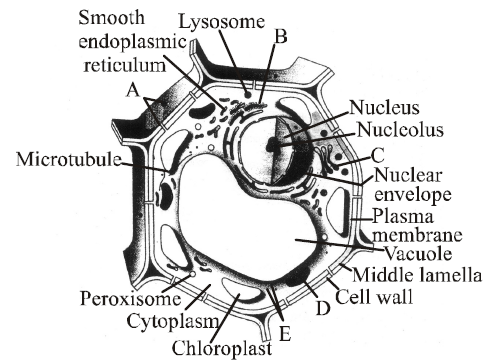
A. A - Plasmodesmata, B - Rough endoplasmic reticulum, C - Golgi apparatus, D - Mitochondrion, E - Ribosomes
B. A - Desmosome, B - Rough endoplasmic reticulum, C - Golgi apparatus, D - Mitochondrion, E - Ribosomes
C. A - Plasmodesmata, B - Smooth endoplasmic reticulum, C - Golgi apparatus, D - Mitochondrion, E - Ribosomes
D. A - Tight junction, B - Rough endoplasmic reticulum, C - Golgi apparatus, D - Mitochondrion, E -Ribosomes
Answer : A

A. A - Plasmodesmata, B - Rough endoplasmic reticulum, C - Golgi apparatus, D - Mitochondrion, E - Ribosomes
B. A - Desmosome, B - Rough endoplasmic reticulum, C - Golgi apparatus, D - Mitochondrion, E - Ribosomes
C. A - Plasmodesmata, B - Smooth endoplasmic reticulum, C - Golgi apparatus, D - Mitochondrion, E - Ribosomes
D. A - Tight junction, B - Rough endoplasmic reticulum, C - Golgi apparatus, D - Mitochondrion, E -Ribosomes
Answer : A
37. Match column-I (scientists) with column-II (discovery) and select the correct option.
A. A I, B III, C IV, D II
B. A I, B III, C II, D IV
C. A III, B I, C IV, D II
D. A I, B IV, C II, D III
Answer : A
| Column-I | Column-II |
|---|---|
| A. Leeuwenhoek | I. First saw and described a living cell |
| B. Robert Brown | II. Presence of cell wall is unique to plant cells |
| C. Schleiden | III. Discovered the nucleus |
| D. Schwann | IV. All plants are composed of different kind of cells |
A. A I, B III, C IV, D II
B. A I, B III, C II, D IV
C. A III, B I, C IV, D II
D. A I, B IV, C II, D III
Answer : A
38. Which of the following lacks cell wall?
A. Gametes
B. Amoeba
C. Mycoplasma
D. All of these
Answer : D
A. Gametes
B. Amoeba
C. Mycoplasma
D. All of these
Answer : D
39. The diagram given below represent a filuid mosaic model of plasma membrance. Match the components marked as A, B, C, D and E in the diagram below from the list (i) to (vii).
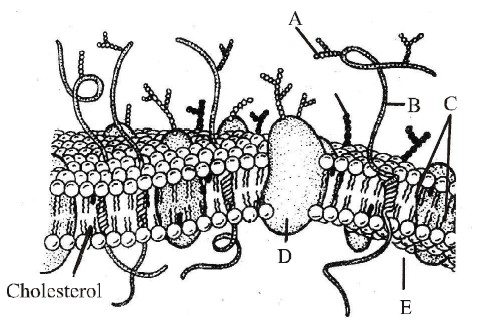
A. A - (i), B - (ii), C - (iii), D - (iv), E - (v)
B. A - (ii), B - (i), C - (iii), D - (iv), E - (v)
C. A - (i), B - (ii), C - (iii), D - (iv), E - (vi)
D. A - (i), B - (ii), C - (iii), D - (vii), E - (v)
Answer : A

- Sugar
- Protein
- Lipid bilayer
- Integral protein
- Cytoplasm
- Cell wall
- External protein
A. A - (i), B - (ii), C - (iii), D - (iv), E - (v)
B. A - (ii), B - (i), C - (iii), D - (iv), E - (v)
C. A - (i), B - (ii), C - (iii), D - (iv), E - (vi)
D. A - (i), B - (ii), C - (iii), D - (vii), E - (v)
Answer : A
40. The best material for study of structure of cell membrane is
A. RBC of human
B. RBC of frog
C. cheek cell of human
D. liver cell of rat
Answer : A
A. RBC of human
B. RBC of frog
C. cheek cell of human
D. liver cell of rat
Answer : A
41. Which of the following is incorrect ?
A. Mycoplasma is the smallest cell (0.3 �).
B. Bacteria are 3 to 5 �m in size.
C. The largest cell is the egg of an ostrich.
D. Nerve cells are some of the smallest cells.
Answer : D
A. Mycoplasma is the smallest cell (0.3 �).
B. Bacteria are 3 to 5 �m in size.
C. The largest cell is the egg of an ostrich.
D. Nerve cells are some of the smallest cells.
Answer : D
42. Identify the components labelled A, B, C and D in the given section of cilia/flagella showing different parts. Choose the option which shows the correct labelling of parts.
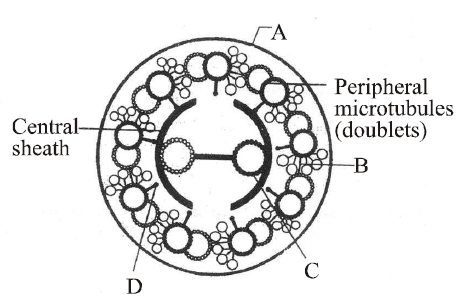
A. A Plasma membrane, B Interdoublet bridge, C Central microtubule, D Radial spoke
B. A Plasma membrane, B Arm, C Central microtubule, D Radial spoke
C. A Plasma membrane, B Interdoublet bridge, C Hub, D Radial spoke
D. A Plasma membrane, B Interdoublet bridge, C Hub, D Arm
Answer : A

A. A Plasma membrane, B Interdoublet bridge, C Central microtubule, D Radial spoke
B. A Plasma membrane, B Arm, C Central microtubule, D Radial spoke
C. A Plasma membrane, B Interdoublet bridge, C Hub, D Radial spoke
D. A Plasma membrane, B Interdoublet bridge, C Hub, D Arm
Answer : A
43. Lysosomes contain
A. carbohydrates
B. hormones
C. nucleic acids
D. hydrolases.
Answer : D
A. carbohydrates
B. hormones
C. nucleic acids
D. hydrolases.
Answer : D
44. In prokaryotes, chromatophores are
A. specialized granules responsible for colouration of cells
B. structures responsible for organizing the shape of the organism.
C. inclusion bodies lying free inside the cells for carrying out various metabolic activities.
D. internal membrane system which becomes extensive and complex in photosynthetic bacteria.
Answer : D
A. specialized granules responsible for colouration of cells
B. structures responsible for organizing the shape of the organism.
C. inclusion bodies lying free inside the cells for carrying out various metabolic activities.
D. internal membrane system which becomes extensive and complex in photosynthetic bacteria.
Answer : D
45. Chromosomes having equal or almost equal arms are called
A. metacentric
B. acrocentric
C. polycentric
D. acentric.
Answer : A
A. metacentric
B. acrocentric
C. polycentric
D. acentric.
Answer : A
46. Microtubules, motor proteins, and actin filaments are all part of the
A. mechanism of photosynthesis that occurs in chloroplasts.
B. rough ER in prokaryotic cells.
C. cytoskeleton of eukaryotic cells.
D. process that moves small molecules across cell membranes.
Answer : C
A. mechanism of photosynthesis that occurs in chloroplasts.
B. rough ER in prokaryotic cells.
C. cytoskeleton of eukaryotic cells.
D. process that moves small molecules across cell membranes.
Answer : C
47. In the given figure of animal cell, one orginelle is marked as A. Select the correct identification and function of the organelle A from the given option.
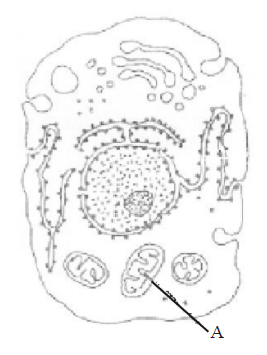
A. Endoplasmic reticulum Synthesis of lipids.
B. Mitochondria Produce cellular energy in the form of ATP.
C. Golgi body Provides packaging material.
D. Lysosomes Secrete hydrolytic enzymes.
Answer : B

A. Endoplasmic reticulum Synthesis of lipids.
B. Mitochondria Produce cellular energy in the form of ATP.
C. Golgi body Provides packaging material.
D. Lysosomes Secrete hydrolytic enzymes.
Answer : B
48. Study the following statements on cilium or flagellum and answer the question.
Which of the above statements are correct?
A. (i) and (ii)
B. (i), (ii), (iii) and (iv)
C. (i) and (iv)
D. (ii) and (iii)
Answer : B
- Cilium / Flagellum contains an outer ring of nine doublet microtubules surrounding two singlet microtubules.
- Cilia are smaller which work like oars, causing the movement of either the cells or surrounding fluid.
- Flagella are comparatively longer and responsible for cell movement.
- Cilium and flagellum are covered with plasma membrane.
Which of the above statements are correct?
A. (i) and (ii)
B. (i), (ii), (iii) and (iv)
C. (i) and (iv)
D. (ii) and (iii)
Answer : B
49. The best way to identify a cell as either prokaryotic or eukaryotic is to determine whether
A. it came from a single-celled or multicellular organism.
B. it has a nucleus.
C. it has a plasma membrane.
D. it has cytosol.
Answer : A
A. it came from a single-celled or multicellular organism.
B. it has a nucleus.
C. it has a plasma membrane.
D. it has cytosol.
Answer : A
50. Satellite means
A. terminal part of the chromosome beyond secondary constriction.
B. terminal part of the chromosome beyond primary constriction.
C. terminal part of chromosome beyond tertiary constriction.
D. none of the above
Answer : A
A. terminal part of the chromosome beyond secondary constriction.
B. terminal part of the chromosome beyond primary constriction.
C. terminal part of chromosome beyond tertiary constriction.
D. none of the above
Answer : A
Sharing is caring
Related Post
1000+ Chemical Engineering Thermodynamics Multiple Choice Question Answer [Solved]
Strength of Materials MCQ Solved Paper for RRB JE
1000+ DBMS MCQ for GATE [Solved]
NEET PG - Current Affairs February 2023 1000+ MCQ [Solved] PDF Download
General Biology Set 2 MCQ Solved Paper for SSC CHSL
SSC CPO - Steam Boilers, Engines, Nozzles & Turbines 1000+ MCQ [Solved] PDF Download